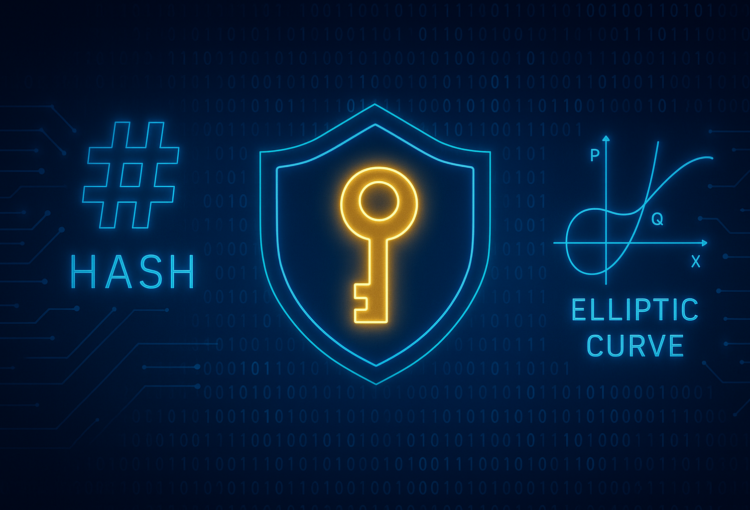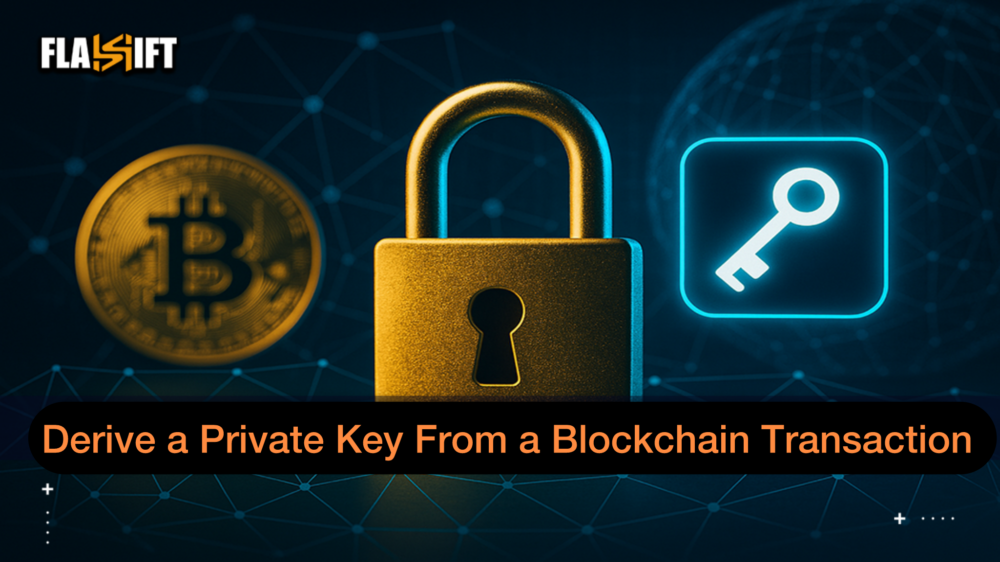Derive a Private Key from a Blockchain Transaction | Imagine sending a crypto transaction and wondering: “Wait… could someone trace this back and somehow figure out my private key?” You wouldn’t be the first to ask. As blockchain technology becomes more mainstream, so do the myths, fears, and half-truths, especially when it comes to security.
This page examines a crucial question at the heart of cryptocurrency safety: Is it possible to derive a private key from information on the blockchain? Flashift will break down how public and private keys work, what gets exposed in a transaction, and why the math behind blockchain cryptography makes such an attack (fortunately) close to impossible.
Whether you’re a curious newcomer or a seasoned trader safeguarding assets on platforms like Flashift, understanding the limits of what’s visible on-chain is crucial to managing your risk and your peace of mind.
Let’s separate fact from fiction, and by the end, you’ll know exactly what’s at stake (and what isn’t).
Understanding the Basics of Public vs. Private Keys

What Is a Private Key in Crypto?
Think of a private key as the master password to your digital wallet, a unique, randomly generated string of letters and numbers that gives you full control over your funds. It lets you access, manage, and transfer cryptocurrency; lose it, and you essentially lose access to your assets forever. Unlike a typical password, private keys are extremely long (usually 64‑hexadecimal characters) and virtually impossible to guess by brute force . In the crypto world, yourprivate key equals ownership.
How Public and Private Keys Work Together
When you generate a private key, it mathematically produces a public key, which in turn creates your wallet address. Even though the public key is visible to everyone, the math is one-way, you can’t reverse-engineer the private key from it. During a transaction, your private key is used to create a digital signature, which proves you own the associated public key, and by extension, the coins.
When you send a transaction, your wallet signs it with your private key, then broadcasts the signature along with transaction details. Network nodes use your public key to verify the signature, confirming the transaction is legit, without revealing your private key.
Role of Wallets and Digital Signatures
Your wallet is where public and private keys are stored securely, it acts like a lockbox for your crypto credentials. It generates digital signatures by combining your private key with the transaction data and a one-time random “nonce.” That signature is unique to each transaction, preventing others from reusing it maliciously.
The digital signature mechanism ensures two things:
- Authenticity: That the transaction came from the rightful owner of the private key.
- Integrity: That transaction details have not been tampered with during broadcast.
Because of this, your private key never leaves the wallet, and no publicly visible data on the blockchain can be used to reconstruct it. It’s math and security design working together to protect your assets.
Read More: How to get Monero transaction private key
Cryptographic Principles That Protect Private Keys

Elliptic Curve Cryptography (ECC) in Practice
Blockchain networks like Bitcoin and Ethereum rely on Elliptic Curve Cryptography (ECC) to generate secure key pairs. A private key is used to compute a corresponding public key through elliptic curve point multiplication: a one-way mathematical operation that is straightforward in the forward direction but virtually impossible to reverse. The strength of ECC lies in the elliptic curve discrete logarithm problem, which remains intractable with current computing power and protects against deriving private keys from public data.
Why Hash Functions and Signatures Are One-Way
Beyond ECC, blockchains incorporate hash functions and digital signatures to secure transactions. When you sign a transaction, your wallet combines your private key with the transaction data and a random nonce. The resulting signature can be publicly verified using your public key—but this process is cryptographically one-way. Neither the signature nor the transaction hash can be used to reveal your private key . This design ensures that even visible blockchain data does not leak any secret information.
How Modern Blockchains Prevent Reverse Engineering
Blockchains are built on multi-layered cryptographic defenses:
- One-Way Functions: ECC and hash functions like SHA-256 are intentionally non-reversible.
- Randomized Signatures: Each transaction uses a unique nonce, which means duplicate transactions produce different signatures—preventing attackers from correlating patterns.
- Secure Protocols: The signature verification process (e.g., ECDSA, EdDSA) confirms authenticity without exposing private key components.
Together, these protocols make it computationally infeasible to reconstruct a private key, even with unlimited access to public keys, transaction data, and digital signatures. Unless a private key is leaked or a major cryptographic breakthrough (like a fully functional quantum computer) occurs, your key remains safe.
Theoretical Risks and Academic Research
What Would It Take to Crack a Private Key?
The strength of today’s cryptographic systems rests on mathematical complexity. To derive a private key from a public key, an attacker would need to solve the Elliptic Curve Discrete Logarithm Problem (ECDLP)—an exponential-time task for classical computers because of the vast keyspace (2²⁵⁶ possibilities). Even guessing keys by brute force would take longer than the age of the universe with current technology .
The Role of Quantum Computing in This Debate
Quantum computers change the game—Shor’s algorithm, when powerful enough, can theoretically break elliptic curve encryption like the secp256k1 used in Bitcoin and Ethereum. Research shows that cracking a 256-bit ECC key would require around 2,330 logical qubits (and far more physical qubits after error correction). Experts estimate that such quantum computers are at least a decade away, and even then, they must operate coherently and reliably—no small technical feat.
Realistic Threats in 2025 and Beyond
- Storage vs. Transit Risks: If you reuse an address, your public key becomes permanently visible on-chain—opening a theoretical window for quantum attacks until the transaction confirms.
- Quantum Readiness: Analysts warn that 25% of Bitcoin holdings could be vulnerable to Q-Day—when quantum computers capable of breaking ECC first emerge.
- Research & Response: Ongoing research is focusing on post-quantum cryptography (PQC)—new algorithms designed to resist quantum attacks. NIST is already moving toward standardizing PQC algorithms.
Even though these threats are still theoretical, they’re accelerating efforts to build quantum-resistant blockchains (like lattice-based or isogeny-based systems). Some blockchains are already experimenting with hybrid signature schemes to prepare for the future.
Bottom Line
While it’s currently practically impossible to derive a private key from on-chain data, quantum computing presents a looming threat that demands preparation. That means:
- Avoiding address reuse
- Watching advancements in quantum computing
- Supporting blockchain projects transitioning to post-quantum cryptography.
Conclusion, Why Your Private Key Is Still Safe
Key Takeaways for Beginners and Traders
Your private key is the bedrock of your cryptocurrency security. Generated via strong cryptographic methods and stored privately in wallets or hardware devices, it is never broadcasted or exposed through blockchain transactions. The mathematics behind elliptic-curve cryptography (ECC) ensures that reconstructing your private key from on-chain data is effectively impossible, making your funds safe as long as you follow good security practices.
Best Practices to Keep Your Wallet Secure
- Use cold storage for significant holdings; keep private keys offline where they’re immune to online attacks.
- Segment your usage: Use hot wallets for small, everyday needs, and separate “vault” wallets for savings.
- Enable two-factor authentication (2FA) and strong passwords; never reuse credentials.
- Safeguard your seed phrase offline—never store it digitally or online.
- Avoid phishing attacks and connection to risky dApps — be wary of unfamiliar links or browser pop-ups.
- Quick breach response: if you suspect compromise, transfer funds to a new wallet immediately.
Don’t Trust, Verify: Know What’s Actually Possible
There’s no way to derive a private key from a transaction or a public address—it’s mathematically and cryptographically barred by design. Even in extreme cases like physical tampering or future quantum threats, these risks remain speculative and remote. Still, staying informed, using high-quality wallets (like hardware or multisig devices), and remaining cautious reflects an empowered, security-savvy mindset.
Final Word
Rest easy: your private key remains safe today. But true digital security is a journey, not a destination. Be proactive and diligent—combine cryptographic trust with real-world best practices—and you can confidently hold and use crypto with peace of mind.
FAQ
-
Can someone derive my private key from a blockchain transaction?
No. Private keys are never included in transaction data. Blockchain only shows public keys, addresses, and signatures—but not your secret key. Thanks to one-way cryptography (ECC and hash functions), it’s practically impossible to reverse-engineer them.
-
Does a new private key get created for every transaction?
Not usually. Most wallets use hierarchical deterministic (HD) structures—papers say each new address uses a new key pair, but all keys are derived from a single seed phrase. You won’t see a new private key every time you send a transaction unless your wallet specifically does it.
-
What happens if I lose my private key or seed phrase?
If you lose the private key or seed phrase, you lose access to your funds. There’s no way to recover or regenerate them without the original information.
-
Is quantum computing a real threat to my private key?
It’s a theoretical future risk. Current quantum computers aren’t powerful enough to break ECC. Experts estimate we’re still 10+ years away from plausible quantum attacks—and blockchains are prepping with post-quantum cryptography .
-
What are the biggest real-world risks to private key security?
Most breaches happen due to human error: malware, phishing, poor storage methods, or hacked custodial services. Blockchain itself isn’t the weak link—wallet management is.
-
How can I securely store my private keys?
Best practices include using hardware wallets (cold storage), paper or metal backups, multisig setups, and keeping keys offline. Protect them with strong passwords, 2FA, and secure backups in multiple safe locations.
-
Are there any signs someone is trying to brute-force my private key?
Not directly. Because brute-forcing ECC keys is practically impossible, if someone had access, it would more likely come from malware, leaked keys, or compromised devices—not blockchain transactions.






